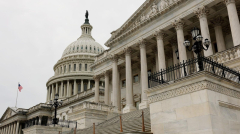Topline
A report released by the Congressional Budget Office on Wednesday shows spending loss from the government shutdown will cost the U.S. between $7 billion to $14 billion in gross domestic product—the latest of many economic ails from the closure.
WASHINGTON, DC – SEPTEMBER 29: A view of the U.S. Capitol on September 29, 2025 in Washington, DC. Senate Minority Leader Charles Schumer (D-NY), Senate Majority Leader John Thune (R-SD), Speaker of the House Mike Johnson (R-LA) and House Minority Leader Hakeem Jeffries (D-NY) are scheduled to meet Monday afternoon with President Donald Trump at the White House to try and avoid a government shutdown at midnight September 30. (Photo by Anna Moneymaker/Getty Images)
Getty Images
Key Facts
The CBO, a nonpartisan federal agency that provides budget and economic information to Congress, estimates the majority of the lost money during the shutdown would come from the reduction in federal spending from delayed compensation for federal workers, delayed spending on goods and services and delayed spending on food stamps.
The budgetary agency says while most of the losses from the spending reduction would be recouped when the shutdown ends, not all would be made up, causing a 1%- 2% hit to GDP from lost economic activity.
CBO calculations show that the economy would lose $7 billion in GDP if the shutdown ends this week, $11 billion if it ends in mid November and $14 billion if it ends at the end of November.
During the shutdown, thousands of federal employees have been laid off and furloughed, multiple federal agencies have suspended operations, while government benefits like the Supplemental Nutrition Assistance Program will soon be delayed.
Tangent
A JPMorgan report also showed that reduced government operations from the shutdown could pose issues for the economy as key data the Federal Reserve relies on in determining interest rates has been delayed.
Key BackgroundThe government shutdown, which has been ongoing since Oct. 1 as Republicans and Democrats in Congress have failed to reach an agreement on a spending plan for the government, is now the second-longest shutdown in history. The Congressional Budget Office estimated the government shutdown in 2018-19, which lasted a record-setting 35 days, led to an $11 million short-term hit and a $3 billion long-term loss to the U.S. economy. Many critical functions from federal agencies have either been suspended or will soon be—like the publication of official economic data, production of monthly reports and surveys and disbursement of food assistance. Last week, thousands of federal workers missed their paychecks, and have continued to work without pay, according to the Bipartisan Policy Center. President Donald Trump said Saturday that he will direct Defense Secretary Pete Hegseth to “use all available funds” to pay military troops as Politico reported White House officials were weighing using tariff revenue to cover paychecks. Over 42 million Americans will lose access to federal funding for food benefits starting Saturday, with the Trump administration refusing to utilise a $5 billion emergency fund to supplement the program, claiming it’s not legally able to access funds for covering a shutdown. Some states have taken steps to keep providing SNAP benefits to recipients despite the USDA saying the states would not be reimbursed for footing the bill.
Big Number
About $8 billion. That’s how much food assistance programs cost the federal government every month, according to the Department of Agriculture.
Further Reading
- Government Shutdown: Federal Employees Miss First Full Paycheck
- SNAP Funding Has ‘Run Dry’ For November, Trump Administration Says—Here’s What To Know
- Monday Evening Air Traffic Staffing Issues Cause Flight Delays In Newark, Dallas And Austin





